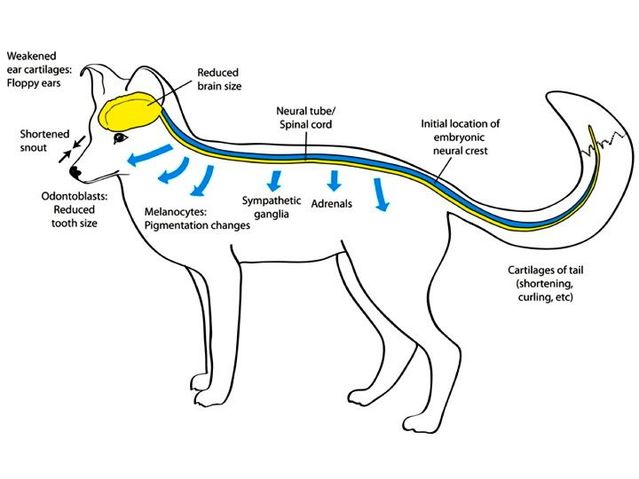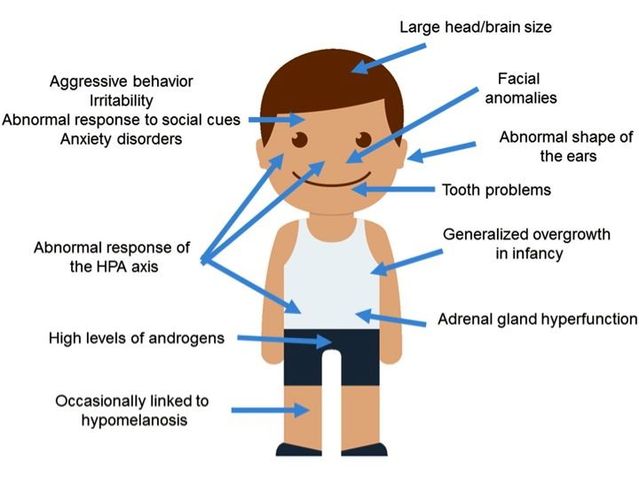Autism
Autism and "Domestication Syndrome" in Humans
Signs of "domestication syndrome" in humans are generally attenuated in autism.
Posted August 24, 2016
Autistic authors often describe themselves as aliens from outer space, but remarkable new research by Antonio Benítez-Burraco, Wanda Lattanzi, and Elliot Murphy suggests that many characteristics of people diagnosed with an autism spectrum disorder (ASD) might more accurately be thought in terms of the "self-domestication" of our species.
Where domesticating other species is concerned, examples abound, but perhaps the most striking scientifically is that of the Siberian fox. Closely related to the dog, but never previously domesticated, intensive selective breeding in Novosibirsk involving 45,000 foxes beginning during the Lysenko era in 1959 and continuing until 2000, produced what has been called “an amiable, tail-wagging house pet” with floppy ears, curled tail and lighter coat color compared to their wild originals.
Traits modified in domesticated mammals generally include changes in ear size, shape, and stiffness; shorter snouts and smaller jaws; smaller teeth; and a reduced brain: specifically, the amygdala and limbic system. Other distinctive traits commonly found in domesticated strains are loss of pigmentation; neoteny (retention of immature features in adults); shorter reproductive cycles; and increased docility. The latter is thought to result from reduction in the size and function of the adrenal glands as well as from reduced levels of the fight-or-flight stress hormones which they produce.
According to recent research, the traits that characterize this so-called domestication syndrome emerged as unintended by-products of selection for tameness. They appear to result from mild neural crest cell deficits during embryonic development. Such cells arise from the neural tube shortly after its closure and migrate throughout the embryo, where they differentiate into most of the peripheral nervous system as well as the facial skeleton and pigment cells (appropriately illustrated below by a domesticated fox).

Modern humans exhibit a number of domesticated traits, including reduced brains during the last 50,000 years; changes in dentition; reduction of aggressiveness; and retention of juvenile characteristics; and as Benítez-Burraco, Lattanzi, and Murphy point out, most of these features are generally attenuated in ASD (below).

In adults the abnormal shape of the ears is robustly associated with autistic traits, with higher scores correlating with poorer functioning (…). Regarding the changes in the orofacial region, prepubertal boys with ASD show significant differences in facial morphology compared to typically developing (TD) boys (…). This distinctive facial phenotype is more pronounced in subjects with severe symptoms, significant cognitive impairment, and language regression (…). Concerning tooth peculiarities, children with ASD show greater abnormalities in dentition, including missing teeth, diastemas, or reverse overjets (…). With respect to brain size, head circumference is significantly larger in people with ASD, with nearly 15% suffering from macrocephaly. Higher brain volumes correlate with lower functioning abilities; indeed nearly 9% ASD individuals exhibit brain overgrowth (…). … Specifically, people with ASD show increased volumes of the amygdala (…), which correlate with the severity of their social and communication impairments.
Regarding the behavioral traits associated with the domestication syndrome, these authors point out that
aggressive behaviors are frequent in children with ASD (with about 25% of them having scores in the clinical range), and correlate with lower cognitive outcomes (…). Children with ASD display more reactive than proactive aggression attitudes (…). Likewise, irritability is also commonly observed in affected individuals (…). Additionally, ASD is commonly found to be comorbid with generalized anxiety disorder (…).
In domesticated animals, reduced and delayed adrenal function mentioned at the start also involves reduced function of the sympathetic nervous system and an increase of the duration of the immaturity of the hypothalamic-pituitary-adrenal axis (HPA), which provides a longer period during which socialization can occur.
In ASD the HPA responds in a more sluggish way to physiological or physical manipulation and, as a result, children with autism and anxiety disorders show a blunted cortisol response to psychosocial stress. Given that reduced cortisol responsiveness is significantly related to increased anxiety symptoms, it has been suggested that such a non-adaptive physiological response to psychosocial stress may typify ASD.
Regarding neotenic features, it is noteworthy that children with ASD exhibit an early generalized overgrowth (…). Typically, boys with ASD show increased body size at birth and during infancy, with postnatal overgrowth correlating with lower adaptive functioning, greater severity of social deficits, and poorer verbal skills (…).
Higher levels of androgens are found in children and adolescents with ASD that correlate with the severity of autistic traits and might account for the precocious puberty also reported in this condition. Testosterone significantly affects brain development, particularly targeting the hypothalamus, the amygdala and the hippocampus. High perinatal testosterone concentration negatively correlates with early vocabulary development in TD boys. Women with ASD report significantly more irregular menstrual cycles and dysmenorrhea, and delayed age of menarche seems to correlate with the severity of autistic traits.
Where pigmentation is concerned, the authors note that hypo-melanotic diseases usually entail autistic symptoms, as is commonly observed in Hypomelanosis of Ito. Following a detailed listing of the specific genes involved in both ASD and domestication which I cannot include here, the authors conclude that they have shown that
domesticated traits are absent or are attenuated in people with ASD, and genes that we believe important for the (self)domestication of our species and the evolution of our distinctive cognitive abilities (including language) show abnormal expression patterns in the brains of people with autism. What is more: abnormalities can be traced to the time window when crucial brain rewiring occurs during language acquisition and when changes in the normal configuration of the brain occur in children with ASD.
In fact, the authors focus on language as the key adaptation in domestication, and it is certainly a major factor in what I would call mentalism. Indeed, you could see mentalism—the ability to read others’ minds and understand them in terms of emotion, belief, motive etc.—as the essence of human self-domestication to the extent that it boils down to an ability to get on with your fellow human beings in a way acceptable to them. To the extent that ASD is characterized by deficits in mentalism, seeing it as a form of reduced domestication in the sense described above seems reasonable in much the same way that it does to claim that all cats "have Asperger’s syndrome" (thanks to their semi-domesticated status and solitary ways as compared to dogs).
If I were someone on the autistic spectrum, I would rather think of myself as a less "domesticated" human being than as a complete alien, and I suspect many others would agree. Temple Grandin—an authority on animal behaviour as well as one of the world’s most distinguished autistic authors—certainly does when she remarks that
Autism is a kind of way station on the road from animals to humans… We use our animal brains more than normal people do, because we have to. We don’t have any choice. Autistic people are closer to animals than normal people are [author’s emphasis].
And who wants to be domesticated anyway?
(With thanks to Antonio Benítez-Burraco for his help. See also his own post relating to this.)
References
Grandin, T. and C. Johnson, Animals in Translation: Using the Mysteries of Autism to Decode Animal Behavior. 2005, New York: Scribner.




